ASSOCIATION BETWEEN WHITE MATTER HYPERINTENSITIES AND COGNITIVE FUNCTION CHARACTERISTICS IN ALZHEIMER’S DISEASE
Main Article Content
Abstract
Objectives: Identify the prevalence of white matter hyperintensities in Alzheimer's disease patients. Determine the association between hypertension, diabetes, dyslipidemia and cognitive function characteristics of Alzheimer's disease patients with white matter hyperintensities. Methods: A descriptive cross-sectional study was performed on 112 patients diagnosed with probable Alzheimer's disease at the Ho Chi Minh City University of Medicine and Pharmacy Hospital clinic from January 2003 to May 2023; complete results of cognitive function assessment scales and brain MRI information are available. Results: The average age of the study sample was 67.6 ± 10.5, and the age of disease onset was 65,2±10.5. The proportion of women accounts for 65,2%. The prevalence of white matter hyperintensities in Alzheimer's disease patients is 81,25%. The group of Alzheimer's patients with white matter hyperintensities (WMHs) had a statistically significant higher age of disease onset and average age than the non-white matter hyperintensities (non-WMHs) group (p<0.05). The two groups (WMHs and non-WMHs) had no significant differences regarding vascular risk factors (hypertension, diabetes, dyslipidemia). Alzheimer's disease patients in the moderate-severe WMHs group (equivalent to Fazekas 2-3) exhibited impaired executive function, attention, and language compared to the non-mild WMHs group (equivalent to Fazekas 0-1). The difference in corresponding performance on the three scales of word fluency, reading numbers backward, and Boston identification was statistically significant (p<0.05). Conclusion: White matter hyperintensities account for a large proportion of Alzheimer's disease patients. In Alzheimer’s patients, moderate and severe WMHs impair executive function, attention, and language compared to those with non-mild WMHs. Therefore, it is necessary to monitor the progression of these functions in clinical practice in Alzheimer's disease patients with WMHs.
Article Details
Keywords
Alzheimer’s disease, white matter hyperintensities, cognitive function, MMSE, Fazekas, WMHs
References
2. Hoàng Minh Lợi, Nguyễn Trần Ngọc Trinh, Phùng Hưng, Nghiên cứu mối liên quan giữa suy giảm nhận thức và sa sút trí tuệ với tổn thương não trên cộng hưởng từ, Tạp chí Điện quang & Y học hạt nhân Việt Nam, 2022(46): p. 32-45.
3. Kozberg M. G, Perosa V, Gurol M. E, et al, A practical approach to the management of cerebral amyloid angiopathy, Int J Stroke, 2021. 16(4): p. 356-369.
4. Abraham H. M, Wolfson L, Moscufo N, et al, Cardiovascular risk factors and small vessel disease of the brain: Blood pressure, white matter lesions, and functional decline in older person, J Cereb Blood Flow Metab, 2016. 36(1): p. 132-42.
5. Armstrong Richard, Risk factors for Alzheimer's disease. Folia Neuropathol, 2019. 57(2): p. 87-105.
6. Inoue Y, Shue F, Bu G, et al, Pathophysiology and probable etiology of cerebral small vessel disease in vascular dementia and Alzheimer's disease, Mol Neurodegener, 2023. 18(1): p. 46.
7. Chen Y. C, Tsao H. H, Chu Y. C, et al, Exploring the Spectrum of Subcortical Hyperintensities and Cognitive Decline. J Neuropsychiatry Clin Neurosci, 2018. 30(2): p. 130-138.
8. VandenBerg E, Geerlings M. I, Biessels G. J, et al, White Matter Hyperintensities and Cognition in Mild Cognitive Impairment and Alzheimer's Disease: A Domain-Specific Meta-Analysis, J Alzheimers Dis, 2018. 63(2): p. 515-527.


